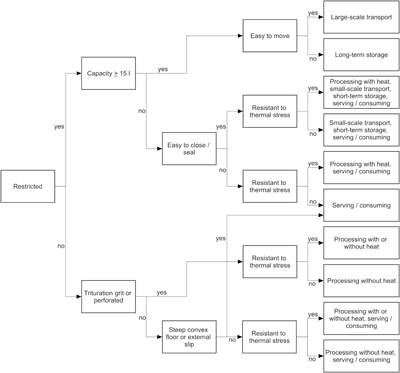
Cite this as: van der Veen, V. 2018 Form Follows Function. A new approach to determining vessel function, Internet Archaeology 50. https://doi.org/10.11141/ia.50.2
Over the years several attempts have been made to assign functions to Roman ceramic vessels using a variety of methods. One such method involves the comparison of our modern typologies to classical sources (Hilgers 1969; Dannell 2006). In some cases there is ample epigraphical evidence as to the use of a particular vessel type, e.g. the so-called motto beakers with their painted texts referring to the consumption of wine (Bös 1958; Symonds 1992, appendix 2). More often, however, such evidence is rather scarce. The forms NB79a (Oelmann 1914) and St. 146 (Stuart 1977a; 1977b), smooth-tempered globular jars with two small handles on their shoulder, are, for example, commonly referred to as Honigtöpfe or honey jars because of a single graffito on such a vessel found at Trier (CIL XIII, 10008 44: Ur(ceus) p(ondo) V s(emis) // Urceus et mel p(ondo) XXVII).
Usewear or alteration analysis is another approach to reconstructing vessel use (Banducci 2014a; 2014b; Biddulph 2008; see also Banducci et al., this volume). Recently, residue analysis has also gained popularity in reconstructing the contents of a vessel and therefore its use (e.g. Oudemans 2007). Both techniques play an important role in furthering our understanding of the use of Roman tableware. For example, frequent cutting of solid foodstuffs will leave behind different markings on a vessel's interior (see Bermejo Tirado, this volume) than would consuming broths or soups with a spoon, whereas repeated heating of food or drink may result in the absorption of food residues in the vessel's wall. However, both signs of use may appear only very localised on the vessel surface, and may be subject to erosion in excavated contexts (Rice 2005, 234-35). Furthermore, such analysis seems best suited to material excavated with these research questions in mind. Finds from older excavations will most likely have been cleaned and stored in a way that is not conducive to the conservation of residues and the more subtle traces of wear.
Thus, these approaches certainly have their merits. However, for larger 'legacy' assemblages it is simply not feasible or necessarily useful to analyse every sherd in such detail. I will therefore take a much more broad-brush approach to the problem.
The flowchart in Figure 1 uses a number of objectively determinable characteristics of all types of Roman ceramics such as height:width ratio and capacity in order to determine the ideal function(s) of a vessel. It is my intention to use this flowchart on all common vessel forms within my research area (Flavian-Trajanic castra and canabae at Nijmegen, NL) and time period, c. 70 to 120 CE. Eventually one or more functions, perhaps expressed as a percentage, will be abstracted per fabric group. Here, however, I will focus on the workings of the flowchart and the criteria behind it.

It should be noted that the flowchart only takes into account the 'ideal use' of a vessel, i.e. the function the potter had in mind when he chose the clay, temper, forming techniques, etc. 'Non-ideal' or actual use is left out of the equation. Recycling of refuse also is not taken into account which, for some categories such as amphorae, might have been an important secondary function. The chart therefore is not meant to determine the function of individual vessels, but rather to trace broad trends within datasets that are too large to study in detail. What the flowchart does take into account, however, is that a particular vessel type might be suitable for more than one function.
In total seven distinct functions have been identified: 1. serving/consuming; 2. processing without heat; 3. processing with heat; 4. short-term storage; 5. long-term storage; 6. small-scale transport; and 7. large-scale transport. In many cases a particular vessel type will be suitable for more than one function.
Finally, it should be noted that the flowchart is only concerned with earthenware containers. It is not applicable to other earthenware objects, including the lids associated with some such containers. It also does not take into account very specific containers such as ink-wells, unguentaria or oil lamps. This, however, is only a minor problem, since most of such specialised forms make up only a very small portion of any ceramic assemblage. Furthermore, the function of specialised containers in most cases can be easily determined without the need of the flowchart.
In this section each criteria used in the flowchart is explained, followed by an example to demonstrate how it operates.

Definition: The diameter of the opening is smaller than both the maximum diameter and the height of the vessel's body.
Relevance: This criterion relates to the accessibility and containment security of a vessel. A restricted vessel, in the sense discussed here, considerably hampers users reaching the entire inner surface, either by hand or with a tool such as a spoon or pestle, and therefore is less suited for processing food or drink by stirring, mixing or grinding. An unrestricted form, on the other hand, is less suited for storage and transport, as it is difficult to seal securely (see 1.2.4. 'Easy to close/seal'). A restricted vessel is commonly defined as having an opening that is narrower than its maximum diameter (Rice 2005; Abbink 1999; Juhl 1995; Henrickson and McDonald 1983). This definition takes into account the relative, though not the absolute, diameter. As long as the opening is wide enough, it does not hamper the accessibility of the vessel even though it is restricted. For the purpose of this flowchart, a restricted vessel is therefore defined as having an opening smaller than both the maximum diameter and the height of the vessel's body.
Definition: The vessel has a capacity equal to or greater than 15 litres.
Relevance: This cut-off point is used to distinguish between large/heavy and small/light vessels. One litre of water weighs roughly 1kg. Oil, being less dense than water, weighs less. Wine, depending on the sugar and alcohol contents, can either weigh slightly more or less than water, while fish sauce weighs more. On average a vessel holding 15 litres of water, oil or wine, including the weight of the vessel itself, would have a gross weight approaching the 20kg mark. Dry cargo such as grain weighs considerably less. Nonetheless, a vessel filled with 15 litres of grain would still have a gross weight of well over 10kg and probably closer to 15kg.
It is more efficient to transport bulk products in a small number of large containers than it is to transport the same amount in a larger number of smaller vessels. This is because of the more favourable gross vs tare weight ratio of a larger vessel. The average capacity of Roman amphorae can be estimated between 15 and 65 litres, with so-called 'Spello' amphorae representing the lower end of the spectrum (Panella 1989, 144). The average capacity of Dressel 2-4 amphorae (Dressel 1899) is estimated between 26 and 34 litres (Cool 2006, 19), while marked Gauloise 4 amphorae (Laubenheimer 1989) from Augst and Kaiseraugst have capacities ranging from 28.3 to at least 34.8 litres (Martin-Kilcher 1994, 60). Finally, Dressel 20 amphorae on average contain between roughly 60 and 65 litres (Cool 2006, 19). A capacity of 15 litres is therefore a good cut-off point to determine whether a vessel is meant for small-scale or large-scale transport.
For the storage function, capacity is also an important criterion. Analysis of vessel capacities has shown that long-term storage vessels have larger volumes than short-term storage vessels (Smith 1983, 268). Within the Roman world dolia are the vessels of choice for long-term storage. Contemporary sources mention dolia with capacities of 260 and 400 litres, while from Ostia dolia are known with capacities ranging from c. 600 to 1200 litres (Gaitzsch 1993, 76-77). However, capacities of dolia found in north-west Europe generally do not exceed 200 litres (e.g. Hiddink 2011, 215; Gaitzsch 1993, 76). Excluded here are small or so-called 'table' dolia, in coarse- and smooth-tempered wares (e.g. Hiddink 2011, 215). These vessels mimic the shape of true dolia, but are significantly smaller and clearly served a different purpose.
As most vessel types either have a capacity that is significantly larger or significantly smaller than the 15 litre cut-off point, it is usually possible to categorise a form without the need for complex volume calculations.
Definition: This category is only relevant for vessels with a capacity of over 15 litres, as small and therefore light vessels are by definition easy to move. This characteristic is hard to qualify objectively, but is based on the vessel's weight, shape and secondary characteristics such as the addition of handles or flanges that provide grip or leverage (Rice 2005, 226).
Relevance: This category is used to distinguish between vessels that are meant for long-term storage, and therefore predominantly remain stationary throughout their life, and vessels used for large-scale transport that need to be manoeuvrable. Broad, flat bases are generally most stable, but also make heavy vessels more difficult to move. Therefore, vessels with wide bases and without handles or flanges, such as dolia, are associated with long-term storage, while vessels with relatively narrow bases and with handles or flanges, such as amphorae, are associated with large-scale transport. On occasion, dolia have been found in shipwrecks. These were apparently cemented in place, preventing shifting, and functioned as fixed receptacles for the transport of wine (Peña 2007, 46). When dolia are found on land, however, these should be associated with storage rather than transport.
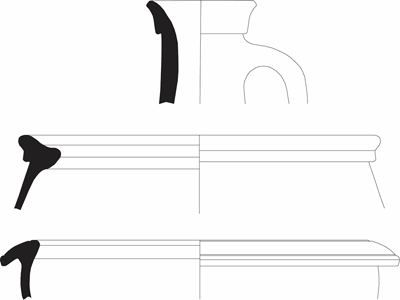
Definition: The vessel can be easily and securely closed or sealed by a lid, wooden plug or pliable cover stretched over the opening. All unrestricted vessels are by definition difficult to close or seal. To be securely closed with a lid, a vessel requires either a flat flange on the outside or a recessed ledge on the inside of the vessel's opening for the lid to rest on. To be closed by a plug, a vessel must have a pronounced neck with fairly straight walls for the plug to be wedged into. Due to their perishable nature wooden plugs tend not to survive. At Velsen, however, several smooth-tempered flagons have been unearthed with their wooden plugs still in place, suggesting that this might have been a common practice (Driessen 2014, 214-15, 222-23). At Voorburg-Arentsburg both wooden, metal and bitumen plugs were found (Driessen 2014, 223; Driessen and Besselsen 2014, 467, 470). To be sealed by tying a pliable cover over the opening, a vessel needs a rolled-over or everted rim to hold a cord that keeps the cover in place (Henrickson and McDonald 1983, 632).
Relevance: Vessels that can be easily closed or sealed are more likely to have been used for storing or transporting, while those that cannot are more suited for serving, consuming or, depending on their thermal characteristics, for processing with heat.
Definition: Trituration grit is found on the internal surface of a vessel. It serves to roughen the surface to facilitate grinding and mixing with a pestle or similar device. Vessels with a perforated bottom serve to separate, in the case of granular material, larger particles from smaller ones, or to separate solid objects from a liquid (i.e. sieve/strainer).
Relevance: Vessels with the addition of trituration grit to their interior surfaces, i.e. mortars, are specifically made for processing without heat. Some mortars have not been roughened in such a manner (Willems 2005, 13; Symonds 2012, 169). Even though these vessels are still perfectly suited for processing without heat, they might have served other purposes as well, such as serving and consuming. Depending on their fabric they are also suitable for processing with heat and indeed occasionally mortars are found with traces of soot on them.
Vessels with perforated bottoms are designed for processing food. Although they can be used to strain hot liquids or possibly for steaming food, their perforations make them unsuitable for cooking.
Definition: This category is only relevant for unrestricted forms. A steep convex floor is defined as a floor that rises towards its centre. External slip refers to the application of a slip or paint to the outside of a vessel.
Relevance: A steep convex floor leads to low thermal resistance and is unsuitable for processing with heat (see resistant to thermal stress). A steep convex floor also restricts the movement of an instrument such as a pestle or spoon. Such vessels are therefore unlikely to have been used for grinding or mixing, i.e. processing without heat.
The application of a slip to the interior of a cooking vessel may prevent food from sticking to it during processing with heat, much like modern day teflon. This is most commonly suggested for Pompeian Red Ware (e.g. Loeschcke 1909, 268; Goudineau 1970, 165), although it has been suggested that this type of ware could also be used for serving/consuming (see Allison 1999, 69-70; Bermejo Tirado this volume and Figure 2). However, the part of a cooking pot that comes into direct contact with the fire, i.e. the exterior, requires a rather coarse surface and hence usually lacks a coating (Velde and Druc 1999, 169).
Additionally, it is assumed that the application of slip or paint on a vessel's exterior had a predominantly decorative function and blackening from soot and fire would certainly detract from the vessel's appearance. Vessels with exterior slip therefore lean more towards the serving and consuming functions, rather than activities such as processing food (Peña 2007, 29; Henrickson and McDonald 1983, 632). It has, however, been argued convincingly that the sigillata cup Drag. 27, which has an external slip, was also on occasion used as a mortar (Biddulph 2008).
The best known exceptions to this rule are terra sigillata mortars such as the Curle 21 (Curle 1911), Drag. 43 and Drag. 45 (Dragendorff 1895), generally thought to have been used for processing food. Both Dragendorff forms tend to have trituration grit added to their interior, however, so are dealt with earlier on in the flowchart. The Curle 21 commonly does not, so it is possible that it should not be classified as a mortar at all (Webster 1996, 66; Biddulph 2008, 99).
Definition: The vessel can withstand the thermal stress caused by repeated heating and cooling. The principal variables affecting resistance to thermal stress are porosity of the fabric, mineral inclusions/temper, thermal expansion and the shape of the vessel.
Relevance: Porosity has a significant influence on the thermal resistivity of a vessel, although this influence is far from straightforward. Large, open and connected pores permit hot gases to pass throughout the body, thereby increasing thermal conductivity and thermal stress resistance (Velde and Druc 1999, 161; Grimshaw 1971, 420-21 in Rice 2005, 368). Small and unconnected pores, on the other hand, prevent heat propagation (Velde and Druc 1999, 161) and pores connecting with the vessel surface reduce both the thermal effectiveness and thermal shock resistance of the fabric (Santacreu 2014, 155). Porosity might also increase thermal stress resistance because when a crack reaches a void its propagation is arrested (Rye 1981, 27). On the other hand, porosity may also help bring about the gradual weakening and loss of strength characteristic of cumulative thermal fatigue (Lawrence and West 1982, 225-26).
Coarse-tempered fabrics with abundant mineral inclusions or tempers significantly increase the effective fracture surface, favouring the formation of micro-pores around the non-plastic components, preventing the propagation of fractures and subsequent breakages (Santacreu 2014, 152). Ideally, vessels meant for use with heat have inclusions with a coefficient of thermal expansion similar to or less than that of the clay. Calcite, plagioclase and several heavy minerals have similar coefficients to fired clays, while grog has the same, because it is fired clay (Rye 1981, 27; Rice 2005, 229).
The shape of a vessel can also affect its resistance to thermal stress. Uneven thickness and sharp angles are best avoided, as these concentrate the stresses occurring in the pot (Rye 1981, 27; Santacreu 2014, 179). Cooking pots that are placed directly into a cooking fire tend to have rounded bottoms and simple smooth body contours. Apart from some hand-made vessels, virtually all Roman ceramic vessels thought to have been used for cooking tend to have flat bottoms, indicating they were probably placed on a stove or grill over the fire rather than directly in the fire.
On the basis of the above criteria, coarse-tempered and hand-made vessels seem ideally suited to processing with heat. This interpretation is further supported by evidence of the common find of traces of soot on the bottom and lower wall fragments of vessels in these fabrics. A final variable is wall thickness. Decreasing wall thickness will lessen the thermal gradient and reduce thermal stress in a vessel (Velde and Druc 1999, 161; Lawrence and West 1982, 226). The average wall thickness of coarse-tempered and hand-made vessels can be estimated to be about 0.5 and 0.7cm respectively (Van Enckevort 2012, 27). It can therefore be suggested that vessels with wall thicknesses well above these averages, can be considered unsuitable for processing with heat. On the other hand, it will be obvious that very thin-walled vessels will not stand up to being placed in a fire either.
This characteristic is somewhat difficult to quantify. However, on the basis of the abovementioned parameters it becomes clear that coarse-tempered wares and hand-made wares seem best suited for food processing using heat.
For some vessel forms the flowchart (Figure 1) might seem somewhat superfluous. It is, for example, widely accepted from archaeological and documentary evidence that amphorae are well suited for large-scale transport. For other vessel groups, however, the flowchart might provide some new perspectives on their use(s). This can be illustrated by the following example.
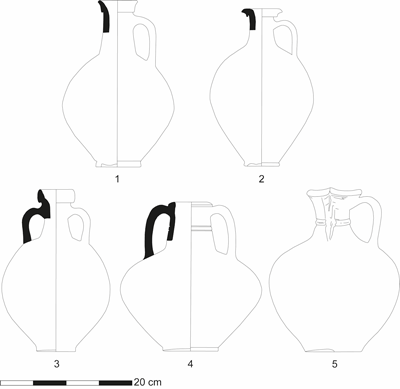
Among Dutch specialists in Roman ceramics it was very common to make a strict functional distinction between smooth-tempered one-handled flagons (kruiken) and two-handled flagons (kruikamforen) (Figure 4). While one-handled flagons were regarded as tableware, their two-handled counterparts were thought to have been used for storing liquids. Although this distinction is still common in many field reports, ceramics specialists have recently argued against it (Hiddink 2011, 121; Van Enckevort 2012, 253). The division into two separate functional categories is probably based, at least in part, on two main similarities to other vessel types: that of one-handled smooth-tempered flagons to coarse-tempered jugs that are ideally suited for pouring thanks to their spout and single handle; and that of two-handled flagons to amphorae that are clearly meant for transport.
The apparent similarity of one-handled flagons to jugs is invalidated by crucial differences in form and fabric. In terms of the flowchart, jugs are restricted forms, but cannot be closed because of their spouted rims, which make them ill-suited for storage or transport. Jugs are generally made in a coarse fabric that is identical to that of cooking pots, so they should hold up well to thermal shock. Coarse-tempered jugs are in fact regularly found with traces of soot on their exterior and calcium carbonate on their interior, indicating that they were sometimes used for boiling water (Batigne and Desbat 1996). This leaves these coarse-tempered jugs the functions of processing with heat and serving/consuming. One-handled flagons, on the contrary, are easy to close or seal and their smooth, generally soft fabric means that they do not stand up well to thermal stress. Consequently, they are suitable for small-scale transport, short-term storage and serving/consuming.
While two-handled flagons and large transport amphorae are superficially similar, two-handled flagons are not necessarily larger than one-handled specimens. In fact, both one- and two-handled flagons come in a large range of sizes and there is a significant overlap. Actually, there seems to be no functional difference between one- and two-handled flagons. Both are restricted forms with capacities of less than 15 litres and are similarly easy to close or seal and neither stands up well to thermal stress. This leads to both being classified as suitable for small-scale transport, short-term storage and serving/consuming.
To test this deviation from common opinion I will briefly examine depositional differences between both one- and two-handled flagons.
Within grave assemblages there appears to be a clear preference for one-handled flagons. For example, the Nijmegen-East grave assemblages include 390 one-handled flagons and only 18 two-handled ones (Stuart 1977b, 46-53, 54-57), while in Nijmegen-West the ratio is 28:2 (Koster 2013, 106, table 9). In calculating this ratio, stray finds reported by Koster (2013, table 9, column E) have been disregarded. At Tiel Passewaaijse Hogeweg there were 71 one-handled flagons and 24 two-handled flagons (Aarts and Heeren 2011, 124, table 7.7). The majority of ceramics in burial assemblages consists of tableware, mainly dishes, cups and beakers. It might therefore be argued that one-handled flagons are more likely to have also served as tableware. It should be kept in mind, however, that the reason why one-handled flagons were so commonly selected as grave goods may be wholly unrelated to how they were used in everyday life. Therefore, an experiment was set up to investigate whether similar differences in deposition could be discerned in a settlement context. This showed that there did indeed appear to be a difference in their deposition, although this is most likely a result of chronology rather than functionality.
For this experiment the dataset used is from the Canisius college excavations carried out by the Katholieke Universiteit Nijmegen in the east of Nijmegen, between 1987 and 1997. The excavated area encompasses remains of three distinct archaeological complexes: a large Augustan military base; a cemetery dating to the pre-Flavian period; and the canabae legionis belonging to the Flavian-Trajanic castra of Legio X Gemina (Kloosterman et al. 2014, 15). The Canisius college dataset consists of more than 500,000 objects of which at least 467,000 are ceramic sherds from the Roman period. The vast majority of these finds belong to the Flavian-Trajanic canabae legionis.
The aim was to establish whether assemblages in the canabae legionis containing one-handled flagons differ from those containing two-handled examples to demonstrate their potentially different functions. Therefore a selection was made of all pits associated with the canabae and these pits were divided into three groups: pits containing only one-handled flagons (Group 1); pits containing only two-handled flagons (Group 2); pits containing both one- and two-handled flagons (Group 3).
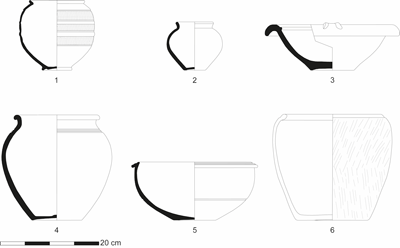
For each of these three groups I compiled a list of the represented vessel forms (other than one- or two-handled flagons). Drawings of the most important vessel forms involved in the following data analyses are shown in Figure 5. Of these forms, only rim fragments were considered and all pre-Flavian vessel forms were removed. To reduce the distorting effect of pits with only a few fragments, those pits containing less than 0.25% of all rims in their pit group were excluded from the analysis. Using the three lists thus compiled, a correspondence analysis (see Sterry this volume) was carried out (Figure 6).
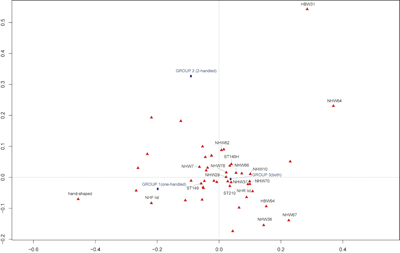
The diagnostics show a primary opposition (x-axis) between Group 1 on the one hand and Groups 2 and 3 on the other. The biggest contributors to this ordering are generally early hand-made vessels and Gallo-Belgic 'cork urns' HBW94, which for the Canisius college excavations are, somewhat unexpectedly, a predominantly late feature (Kloosterman et al. 2014, 57).
According to the diagnostics the main opposition on the y-axis is between Group 2 and Groups 1 and 3. Furthermore, locally produced 'Holdeurn ware' vessel forms (type names with NHW- and -H) clearly cluster predominantly around Group 3, with more forms clustering within the upper part of the graph and therefore nearer to Group 1 than Group 2. Group 1, therefore, contains relatively more Holdeurn ware than Group 2, although both groups must contain relatively little compared to Group 3.
The diagnostics show that of the Holdeurn ware, jars NHW62 and beakers NHW64, in particular, contribute to the ordering of the y-axis. Gallo-Belgic vessels (type names with HBW) also play an important part, with the beaker HBW31 having the highest contribution value of all.
The explanation for the established pattern is most likely a chronological one. To a large degree Holdeurn ware encompasses locally produced imitations of regular coarse- and smooth-tempered vessels. Production of Holdeurn ware did not start before 70 CE. Although some of it could already have found its way into the soil early in the canabae's occupation period, it has been shown that the majority was deposited much later (Kloosterman 2016, 384). Two-handled flagons are plotted nearer to the cluster of Holdeurn ware than one-handled examples and therefore appear to have become slightly more popular as time progressed.
Due to the beaker HBW31's rather long lifespan (c. 60-150 CE) its large contribution to the y-axis cannot be directly linked to chronology, although a functional explanation is also not directly evident either. Disregarding this one outlier, the positions of hand-made vessels and 'cork urns' HBW94 on the x-axis and the Holdeurn ware on the y-axis all show that a chronological, rather than a functional, difference underlies the differing deposition patterns of one- and two-handled flagons.
To investigate this chronological ordering further, Groups 1 and 2 were compared using a scatter plot in which their associated non-flagon vessels are plotted as percentages of all rim fragments in each group.
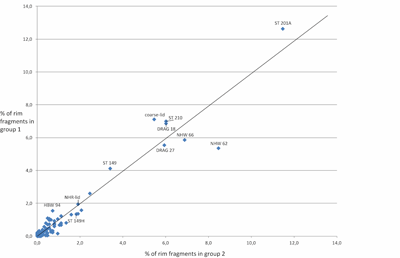
Figure 7 shows a similar trend to the correspondence analysis. The Holdeurn ware jar NHW 62 was found more often in pits containing two-handled flagons, whereas the corresponding form in coarse-tempered ware, St. 201A, is more frequent in pits with one-handled flagons. This same pairing can be identified in the bowl NHW 66, and its regular coarse-tempered equivalent St. 210, and the regular coarse-tempered mortaria St. 149 and Holdeurn ware equivalent St. 149H. The only exception appears to be the Holdeurn lids (NHR-lid), which plot remarkably close to the trend line. However, the regular coarse-tempered lids plot on the side of pits containing only one-handled flagons. This again underlines that, at least within the Canisius college excavations, depositional patterns of one- and two-handled flagons are a result of a (small) chronological rather than a functional difference between the two.
I have shown how, using a set of objectively determinable characteristics, it is possible to characterise the broad function of a vessel, taking into account its inherent multifunctionality. The information gleaned from this model can be generalised per fabric group, to make statements about the general use and function of widely recognised fabric groups in Roman ceramics (terra sigillata/coarse-tempered wares/etc.). This can then be used to interpret or compare assemblages or to map activity areas across a site. In the case study the commonly made functional distinction between smooth-tempered one-handled flagons (kruiken) as tableware and two-handled flagons (kruikamforen) as storage vessels was challenged. However, there need not be such a functional difference at all and both should be classified as suitable for small-scale transport, short-term storage and serving/consuming. Assemblages in the canabae legionis at Nijmegen containing one-handled flagons differ from those containing two-handled examples but the differences between these assemblages are the result of a (small) chronological rather than a functional difference.
Internet Archaeology is an open access journal based in the Department of Archaeology, University of York. Except where otherwise noted, content from this work may be used under the terms of the Creative Commons Attribution 3.0 (CC BY) Unported licence, which permits unrestricted use, distribution, and reproduction in any medium, provided that attribution to the author(s), the title of the work, the Internet Archaeology journal and the relevant URL/DOI are given.
Terms and Conditions | Legal Statements | Privacy Policy | Cookies Policy | Citing Internet Archaeology
Internet Archaeology content is preserved for the long term with the Archaeology Data Service. Help sustain and support open access publication by donating to our Open Access Archaeology Fund.